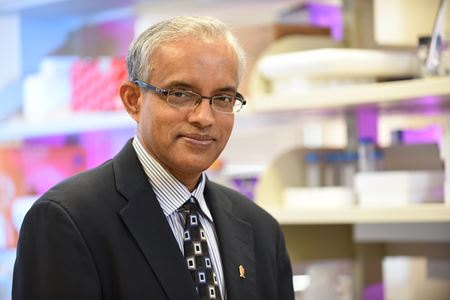INDIANAPOLIS -- An Indiana University Melvin and Bren Simon Comprehensive Cancer Center researcher is identifying the unique biology that may make Black women more susceptible to aggressive breast cancer.
Harikrishna Nakshatri, PhD, received a $1.3 million grant from the Department of Defense – Congressionally Directed Medical Research Program’s breast cancer research program. Nakshatri is associate director of education at the cancer center and the Marian J. Morrison Professor of Breast Cancer Research at Indiana University School of Medicine.
The grant will allow Nakshatri to continue to characterize unique biomarkers within the normal breasts of Black women and how that impacts health disparities in breast cancer.
The research could lead to improved treatments for Black women, who face a higher mortality rate for breast cancer.
“The vast majority of people think of health disparities from the point of view of socio-economic factors, but we are looking at the biologic factors or the biologic basis of health disparities,” Nakshatri said. “This doesn’t account for all cases of health disparity, but there is a certain section where it may inform treatment.”
Nakshatri’s research has shown that normal breast tissue in Black women contains a cell type called PZP at a much higher number when compared to normal breast tissue of Caucasian women. PZP cells increase in number when Caucasian women develop breast cancer, while they are naturally higher in Black women. Nakshatri’s lab is exploring the nature of these PZP cells, if breast cancer can originate from these cells and their role in helping cancer grow.
While Black women develop cancer at the same rate as women of other racial and ethnic backgrounds, the cancer often occurs at a younger age and is more aggressive. Another biologic explanation may come from a genetic mutation called duffy, which is present in Black women with sub-Saharan Africa ancestry.
“That mutation is embedded in this population because it protects them against malarial infection,” said Nakshatri, who is also a researcher at the Vera Bradley Foundation Center for Breast Cancer Research. “Current research has shown that when women who carry this mutation develop breast cancer, it tends to be much more aggressive.”
Nakshatri analyzed DNA from 100 Black women and found that about 40 percent carried this mutation. He then used normal breast tissue of duffy mutation carriers and compared it to cells from African American women who do not carry the mutation. The tissue samples were from the Susan G. Komen Tissue Bank at the IU Simon Cancer, the world’s only collection of healthy breast tissue
“What we found was that the normal breast cells of these duffy carrier women already have signaling molecules for cancer initiation at a much higher level,” he said. “That gives me an explanation of why they may develop breast cancers that are aggressive.”
Already there are existing cancer drugs that target these signaling molecules, but they have not been tested for targeted therapy for specific genetic cases. Nakshatri will use an animal model to find out if those drugs can be used to target breast cancer in Black women who carry the duffy mutation.
“The question we are asking is: Do these women need a different type of treatment if they are carriers of this mutation? Should they go through conventional treatment, or can we add or subtract some of the treatments to make them respond better?” Nakshatri said. “There are many drugs out there that we still need to figure out who will benefit from them; that is our ultimate goal.” Although this research is in the preclinical stage, Nakshatri hopes these findings will lead to clinical studies in the coming years.
###
IU School of Medicine is the largest medical school in the U.S. and is annually ranked among the top medical schools in the nation by U.S. News & World Report. The school offers high-quality medical education, access to leading medical research and rich campus life in nine Indiana cities, including rural and urban locations consistently recognized for livability.




